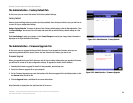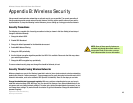
40
Appendix A: Troubleshooting
Frequently Asked Questions
Wireless-G Access Point with Power Over Ethernet
What IEEE 802.11g features are supported?
The product supports the following IEEE 802.11g functions:
• CSMA/CA plus Acknowledge protocol
• OFDM protocol
• Multi-Channel Roaming
• Automatic Rate Selection
• RTS/CTS feature
• Fragmentation
• Power Management
What is Ad-hoc?
An Ad-hoc wireless LAN is a group of computers, each with a WLAN adapter, connected as an independent
wireless LAN. An Ad-hoc wireless LAN is applicable at a departmental scale for a branch or SOHO operation.
What is Infrastructure?
An integrated wireless and wired LAN is called an Infrastructure configuration. Infrastructure is applicable to
enterprise scale for wireless access to a central database, or wireless application for mobile workers.
What is roaming?
Roaming is the ability of a portable computer to communicate continuously while its user is moving freely
throughout an area greater than that covered by a single Access Point. Before using the roaming function, the
user must make sure that the computer is set to the same channel number as the Access Point of the dedicated
coverage area.
To achieve true seamless connectivity, the wireless LAN must incorporate a number of different functions. Each
node and Access Point, for example, must always acknowledge receipt of each message. Each node must
maintain contact with the wireless network even when not actually transmitting data. Achieving these functions
simultaneously requires a dynamic RF networking technology that links Access Points and nodes. In such a
system, the user’s end node undertakes a search for the best possible access to the system. First, it evaluates
such factors as signal strength and quality, as well as the message load currently being carried by each Access
Point and the distance of each Access Point to the wired backbone. Based on that information, the node next
selects the right Access Point and registers its address. Communications between end node and host computer
can then be transmitted up and down the backbone.
As the user moves on, the end node’s RF transmitter regularly checks the system to determine whether it is in
touch with the original Access Point or whether it should seek a new one. When a node no longer receives
acknowledgment from its original Access Point, it undertakes a new search. Upon finding a new Access Point, it
then re-registers, and the communication process continues.


















